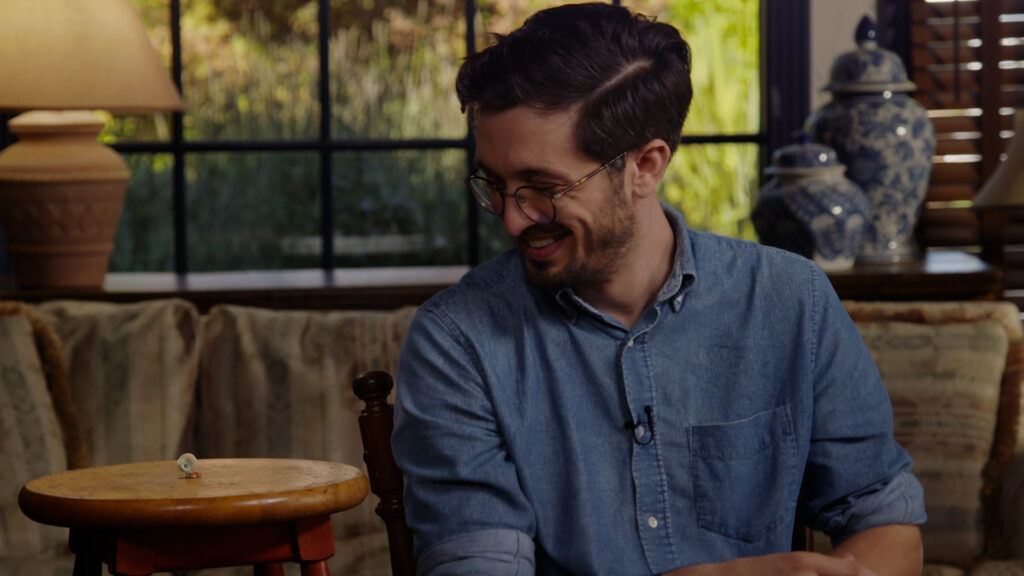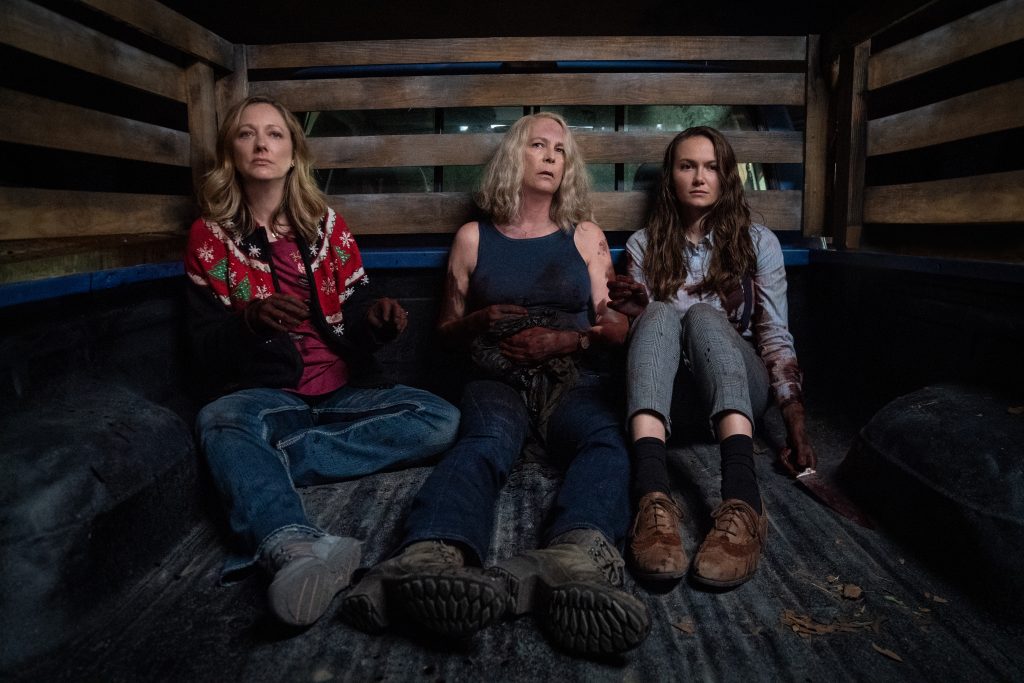June 21, 2022
by Carla Hay

“Marcel the Shell With Shoes On”
Directed by Dean Fleischer Camp
Culture Representation: Taking place in Los Angeles, the animated/live-action film “Marcel the Shell With Shoes On” has a nearly all-white cast of characters (with one Latina) representing the working-class and middle-class.
Culture Clash: A young male seashell and his grandmother, who are living by themselves in an Airbnb rental house after their other family members have gone missing, have to adjust to a new life when a documentary filmmaker moves into the house.
Culture Audience: “Marcel the Shell With Shoes On” will appeal primarily to people who like quirky films that blend animation with live action.

“Marcel the Shell With Shoes On” could have been an excessively cute film about tiny sea shells with human-like characteristics, but this unique movie is an offbeat charmer with an appealing mix of comedy and sentimentality about life and love. The movie has an artistic blend of live action and stop-motion animation that looks organic, not forced. And although there are some parts of the film that get repetitive and not all of the jokes land well, the positive aspects of “Marcel the Shell With Shoes On” far outnumber any of the movie’s small flaws. “Marcel the Shell With Shoes On” had its world premiere at the 2021 Telluride Film Festival and made the rounds at other film festivals, including South by Southwest (SXSW), the Seattle International Film Festival and the San Francisco International Film Festival.
The origin story of “Marcel the Shell With Shoes On” is self-referenced throughout the movie, which has a plot that’s similar to how the movie’s title character first became an international sensation. In real life, filmmaker Dean Fleischer Camp and actress Jenny Slate did a series of short comedy videos called “Marcel the Shell With Shoes On,” beginning in 2010. In these videos, Slate voiced the character of Marcel, a talkative one-inch sea shell with one eye, human feet and a wryly observant and inquisitive view of life. Based on the way that Marcel talks, he has the intelligence and emotional maturity of a human boy who’s about 9 or 10 years old.
These videos about Marcel became a worldwide hit on the Internet and inspired children’s books written by Slate and Flesicher Camp. And now, there’s an entire movie about Marcel. The feature film “Marcel the Shell With Shoes On,” directed by Fleischer Camp (who co-wrote the movie’s screenplay with Slate and Nick Paley) takes viewers on Marcel’s often-emotional journey to find his missing family members. Marcel lives in a middle-class house somewhere in Los Angeles, where the unmarried human couple named Larissa (played by Rosa Salazar) and Mark (played by Thomas Mann), who previously occupied the house, had a bitter breakup. The house is now being used as an Airbnb rental.
Marcel’s wise and practical grandmother Connie (voiced by Isabella Rossellini) is Marcel’s only family member who hasn’t gone missing. Among the those who have gone missing in Marcel’s family (they are all one-eyed small shells with feet) are Marcel’s parents Mario and Connie and Marcel’s brother Justin. What bothers Marcel and Connie the most is that they didn’t have a chance to say goodbye, and they have no idea where the other family members went. Marcel and Connie have photos and illustrations of their family members as visual mementos.
Marcel and Connie have a very close relationship. She often teaches Marcel things about life, often in answer to Marcel’s seemingly endless stream of questions. Connie and Marcel also love to watch “60 Minutes” together and are big fans of “60 Minutes” correspondent Lesley Stahl. Marcel describes Connie as very independent and resourceful. For example, Marcel says that Connie taught herself how to farm. Connie also loves to garden and spends a lot of her time in the home’s garden.
At times, Marcel has a childlike wonder and curiosity about the modern world. Other times, he has a simple clarity about how to react to difficulties or problems because he doesn’t have as much emotional baggage or insecurity as someone who is an adult. Throughout the movie, there are whimsical moments and more serious moments where Marcel’s personality and quirks get various reactions to those around him.
In the beginning of the movie, Marcel says that he and Connie are living by themselves in the house, along with their pet lint named Alan. Their solitude ends when an Airbnb renter moves into the house with his white terrier mix dog named Arthur. He’s a mild-mannered filmmaker named Dean Fleischer-Camp (playing a version of himself), who needs a new place to stay because he has recently separated from his wife. In a case of art imitating life, Slate and Fleischer Camp (who used to spell his surname as Fleischer-Camp) got married in 2012 and then got divorced in 2016.
As expected, Marcel is curious about the house’s new human resident, and the feeling is mutual. It takes Marcel much longer to get used to Arthur, Dean’s dog, since Marcel is sometimes annoyed by how the dog smells and keeps interrupting Marcel like a curious and playful dog would do. Marcel shows Dean around the house, including the potted plant where Marcel sleeps on a slice of bread. Marcel describes where he sleeps as his “breadroom.”
Marcel might seem like a precocious child, but he doesn’t know a lot about modern technology. Dean tells Marcel that he’s making an online documentary. Marcel’s response is “Online? You lost me.” Eventually, Dean shows Marcel how the Internet works when Dean begins posting videos of Marcel online. The videos become an international sensation, with Marcel developing a huge fan base. (Sound familiar?)
Marcel is overwhelmed and often flabbergasted by all this newfound attention. However, he thinks it can be put to good use when he asks Dean to help get the word out about Marcel’s missing family members. You can easily predict which TV news show might get involved. Someone who doesn’t really want to get too caught up in the fanfare is Connie, who is very skeptical of the Internet and all modern technology.
The first third of “Marcel the Shell With the Shoes On” seems like a series of skits weaved together, with a lot of wisecracking remarks from Marcel, as he and Dean start to get to know each other and eventually become friends. The other two-thirds of the movie begin to have more substance when the story focuses more on the search for Marcel’s family members. The movie has themes of love, heartbreak and grief that are handled with sensitivity without being mawkish.
For example, Marcel begins to notice after a while that Dean is very curious about Marcel, but Dean is very reluctant to talk about himself. And it’s not just because Dean wants to be an journalistic documentarian. Dean is having difficulty processing the breakup of his marriage. Dean’s preoccupation with Marcel’s problems are a way for him to cope with or avoid his own personal problems.
The movie doesn’t fully show Dean on camera until a pivotal part of the story when he’s essentially forced to talk about himself. It’s a clever way that the movie has Dean “coming out of the shadows” that reflect his own willingness to be open up more about himself and show more vulnerability. Fleischer Camp gives a solid performance, but the character of Dean seems to know that Marcel is the real star of the show.
“Marcel the Shell With Shoes On” has terrific voice work from Slate and Rossellini, who make an endearing and believable duo as a grandparent and grandchild. Connie isn’t a new character, but this movie is the first time that Connie gets her own backstory and story arc. Not everything in “Marcel the Shell With Shoes On” is comedic, since the movie has some tearjerking moments that might catch some viewers by surprise. In a cinematic era when animated/live-action hybrid films are so focused on dazzling viewers with big adventures that are visual spectacles, it’s nice to have a movie like “Marcel the Shell With Shoes On” that focuses more on everyday emotional connections and appreciating loved ones during life’s ups and downs.
A24 will release “Marcel the Shell With Shoes On” in select U.S. cinemas on June 24, 2022, with an expansion to more U.S. cinemas on July 15, 2022.


